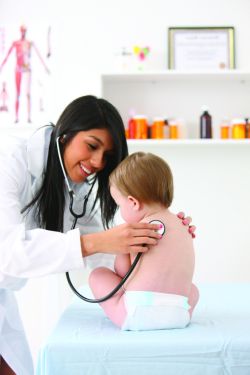
Illness, First Aid & Immunisations
Illness

Children are incredibly resistant and bouts of illness usually pass quickly but parents are bound to worry about their child's health. The most important thing in the case of illness is to trust your instincts - no one knows your child better than you do. If you have any concerns about their wellbeing, contact your GP; even if there proves to be nothing wrong, you will feel reassured.
Try to be aware of signs such as vomiting, a high temperature, cough, runny nose or eyes and unusual behaviour such as excessive crying, irritability, loss of appetite, being listless or drowsy. If you have seen your GP and your baby doesn't seem any better, contact them again that same day. If you are unable to speak to your GP or see them quickly enough, it is perfectly acceptable to take your baby to the Accident and Emergency department at your nearest hospital. If possible, make sure that hospital also has a children's ward.
First Aid
When you have young children, it can never hurt to learn a bit about basic and emergency first aid - there are lots of books on the subject or you can book a course through the Red Cross, St. John Ambulance or your local NHS Ambulance Service. Below, we have listed the most important steps in emergency first aid for your baby: If you ever think that your baby has stopped breathing, you need to first conduct a Primary Survey. This means that you must make sure that it is safe to approach them (for example, if they have suffered an electric shock, make sure that the power is turned off before you do anything else. If you are unable to turn the electricity off, try to move your child away from the power source using a wooden object, such as a broom).
Attempt gentle stimulation of your child by tapping their feet, stroking their neck or by shouting 'hello' or 'wake up' (do not shake your baby under any circumstances). If they do not respond, you should call for help (or get someone else to) while you check your child's airway and breathing and, if necessary, carry out CPR.

Think ABC - Airway, Breathing, CPR!
Airway: place your child on a firm surface; put one hand on your child's forehead and the other under their chin, then gently lift the chin with two fingers only. This will move their tongue away from the back of their mouth. If there is any possibility that your child has suffered a neck injury, however, you should just lift their chin rather than attempting to tilt their head.
Breathing: You should check your child's breathing for no more than ten seconds. To do this, put your ear close to your child's mouth and look to see if their chest is rising and falling, while listening for sounds of breathing and feeling for their breath on your cheek.
CPR: Once you have carried out your primary survey and have confirmed that your child is not breathing, you should follow the steps below - these vary slightly according to whether your child is an infant (under one year old) or over one year old.
Infant Under One Year Old
- Confirm your baby is not breathing.
- If accompanied, send your helper to dial 999 or 112 for an ambulance (112 is recommended if you are calling from a mobile as it gives a clearer signal, although you can also reach this number from landlines and in many other European countries).
- If you are alone, you will have to carry out rescue breaths and chest compressions for one minute before taking the infant with you to call an ambulance.
- Carefully remove any obvious obstruction from the mouth of the infant (it is important not to touch the back of your child's throat as this could cause swelling and further obstruction of their airway) and give five initial rescue breaths.
- You do this by slightly tipping the infant's head back. Seal your mouth over their mouth and nose and breathe gently into them, looking along the chest as you breathe. Fill your cheeks with air and use this amount each time. As the chest rises, stop blowing and allow it to fall. Repeat this five times.
- Having done five rescue breaths, you're now going to do chest compressions.
- Using the tips of two fingers to compress the chest, place your fingers in the centre of the infant's chest (imagine a line joining the nipples and place two fingers along the length of the breastbone below this line) and sharply depress the chest one third of its depth at a rate of 100 compressions a minute. At this speed, you're going to give 30 chest compressions.
- Alternate 30 chest compressions with two rescue breaths without stopping until help arrives or the infant starts to breathe normally.
Child Between One Year And Puberty
- Following your primary survey, you have already established that the child is not breathing normally.
- At this point, if you are accompanied, send your helper to dial 999 or 112 for an ambulance.
- If you are alone, you will need to do one minute's worth of CPR before going to call for help yourself.
- Carefully remove any visible obstruction from the mouth or nose of the child and give five initial rescue breaths.
- Ensure you tip the head back, seal the nose and put your mouth over the child's mouth, forming an airtight seal.
- Breath into the child, ensuring the chest inflates. Do this five times.
- Having done five rescue breaths, you are now going to do chest compressions.
- Place one hand - or two, as appropriate - in the centre of the chest (this does depend on the size of the child). Use the heel of your hand and keep your arms straight.
- Sharply depress the chest one third of its depth at a rate of 100 compressions a minute. At this speed, you are going to give 30 chest compressions.
- Alternate 30 chest compressions with two rescue breaths and keep repeating as necessary until help arrives or the child's breathing is restored to normal.
CPR will buy time for your baby, by allowing oxygen to circulate around their body and preventing damage to their vital organs. However, it is important to phone an ambulance as soon as possible as ambulance staff can use a number of advanced strategies to resuscitate your child.
Please note, that these tips are no substitute for formal first aid training. First aid procedures change from time to time, so the above information may be subject to change. Organisations such as St. John Ambulance now offer email alerts to notify people of changes in first aid procedures, as well as a comprehensive range of online advice.
Immunisation
Immunisation protects us from serious diseases, it works by exposing us to a small part of the virus or bacteria that cause an illness and our bodies react by creating antibodies that will fight the disease should we ever come into contact with the full-blown thing.
Your child should have their first immunisations at two months old, and then again at three and four months - this is known as the DTPHib vaccine and protects against Diphtheria, Tetanus, Pertussis ( Whooping Cough) and Haemophilus influenzae type B (Hib). Other immunisations are given at approximately 13 months, then at three and five years old (before your child starts school) and later, as a teenager. With some immunisations, a booster (or top up) dose is necessary to build up your child's immunity.
Since September 2006, every child starting their routine immunisations at two months of age is offered the pneumococcal vaccine. The Pneumococcal infection can cause very serious illnesses such as meningitis and pneumonia as well as being one of the most common bacterial causes of ear infections. Your doctor's surgery or health centre is likely to run a special immunisation clinic and you will be sent an appointment card when it is time for your baby to be vaccinated.
Immunisations may be in the form of an injection in the thigh or upper arm. All vaccines used in the UK have gone through stringent testing procedures but you may have some concerns about the effects of immunisation on your child. We would advise that you discuss any concerns with your GP or health visitor immediately.
To find out more about your child's immunisation schedule, visit www.immunisation.nhs.uk.
We would advise that you discuss any concerns with your GP or health visitor immediately.
Due to a continuing rise in whooping cough cases, especially in babies too young to have their routine vaccinations, the Department of Health launched a vaccination programme for expectant mothers (from 5 October 2012 onwards). You will be vaccinated between weeks 16 to 32 of your pregnancy as this is the best way to safeguard your baby against whooping cough during their first weeks and months.
To find out more about your child's immunisation schedule, visit nhs.uk/start4life/baby/vaccinations-and-newborn-screening-tests/
Further information:
Childcare Advice
Employment, Finances & Benefits
Health & Lifestyle
Illness, First Aid & Immunisations
Parenthood Advice
Postnatal Depression
Pregnancy Advice
Relationship Difficulties
Useful Contacts
